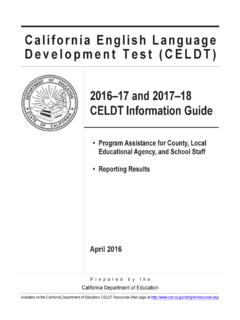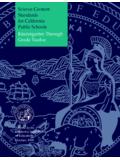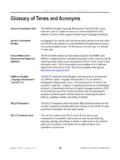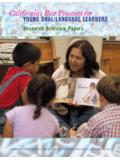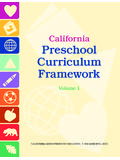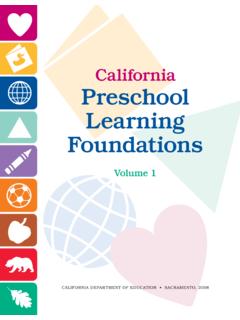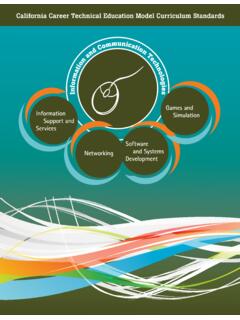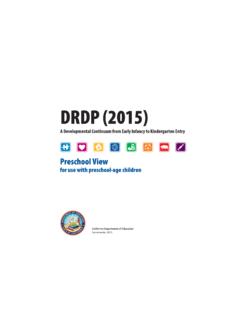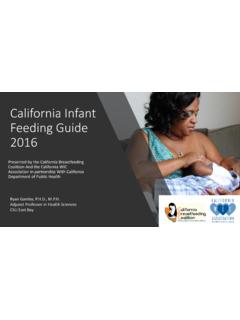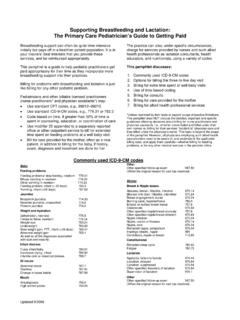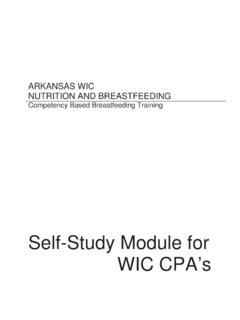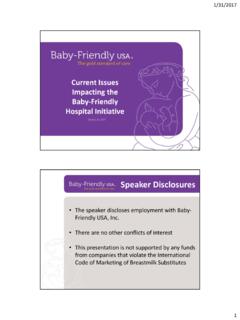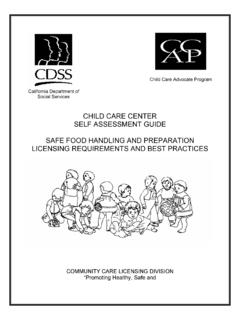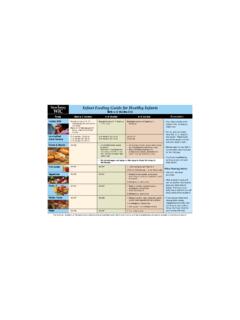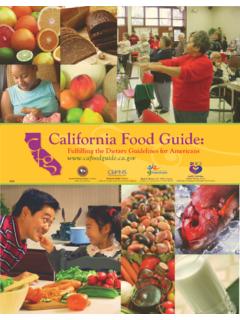Transcription of A Guide to Culturally Sensitive Care
1 A Guide to Culturally Sensitive care Second Edition Developed collaboratively by the california department of education and WestEd Sacramento, 2013. WestEd infant /Toddler Caregiving A Guide to Culturally Sensitive care Second Edition Edited by Elita Amini Virmani and Peter L. Mangione Developed collaboratively by the california department of education and WestEd Publishing Information infant /Toddler Caregiving: A Guide to Culturally Sensitive care , Second Edition, was developed by WestEd, San Francisco. The publication was edited by Faye Ong, working in cooperation with Elita Amini Virmani and Peter Mangione, WestEd; and Sy Dang Nguyen, Consultant, Child Development Division, california Depart . ment of education (CDE). It was prepared for printing by the staff of CDE Press, with the cover and interior design created by Juan D.
2 Sanchez. The document was published by the california department of education , 1430 N Street, Sacramento, CA 95814-5901. It was distributed under the provisions of the Library Distribution Act and Government Code Section 11096. 2013 by the california department of education First edition printed in 1995; reprinted in 2010. All rights reserved ISBN 978-0-8011-1734-3. Ordering Information Copies of this publication are available for purchase from the california Depart . ment of education (CDE). For prices and ordering information, visit http://www. or call the CDE Press sales of ce at 1-800-995-4099. Notice The guidance in infant /Toddler Caregiving: A Guide to Culturally Sensitive care , Second Edition, is not binding on local educational agencies or other entities. Ex . cept for statutes, regulations, and court decisions referenced herein, the document is exemplary, and compliance with it is not mandatory.
3 (See education Code Section ). Prepared for printing by CSEA members ii Contents A Message from the State Superintendent of Public Instruction vi Acknowledgments vii About the Authors x Introduction xi Section One: Understanding the Social Context of infant /Toddler care 1. Chapter 1. Culture and Identity Development: Getting Infants and Toddlers Off to a Great Start 2 Carol Brunson Day The Beginnings of Identity Development Are in Infancy 2 Dimensions of Identity Development 3 The Role of Culture in Development 4. Cultural Empowerment: Preparing infant /Toddler care Teachers for Competent Practice 5 Culture as a Process 6 Culturally Responsive Practices That Support Identity Development 8 References 10 Chapter 2. Prejudice, Bias, and Inequity in the Lives of Infants and Toddlers 13 Louise Derman-Sparks Societal Inequity and Families 14 What Infants and Toddlers See and Hear in Child care Settings 14.
4 Socialization in Two Cultures 16 Practicing Culturally Responsive care 17 Building Blocks of a Culturally Responsive care /Learning Environment 19 Conclusion 22. Glossary 23. References 24 Chapter 3. Inclusion of Children with Special Needs in Diverse Early care Settings 25 Deborah Chen Diverse Perspectives on Disability 25. Differences in Perspectives 27. Understanding Early Intervention Terminology, Eligibility, and Intervention 28 Eligibility for Early Intervention Services 28 Initiating the Early Intervention Process: Making Referrals 29 iii Individualized Family Service Plan 33. Teaming with Interpreters 33. Gathering Information from Families 34. Sharing Information with Families 36 Supporting Participation and a Sense of Belonging in the Early care Setting 36. Person-First Language 37. Universal Design for Learning 37.
5 Teaming with Early Intervention Service Providers 38. Embedding Speci c Learning Opportunities in Daily Routines 38. Questions to Guide Practice 39. Conclusion 39. References 40 Section Two: Becoming Informed About Cultural Practices and Cultural Communities 41 Chapter 4. A Cultural Communities and Cultural Practices Approach to Understanding infant and Toddler care 42. Alison Wishard Guerra and Sarah Garrity Participation in Cultural Practices at Home and in the Early care Setting 44. Understanding Cultural Communities 45 Understanding Cultural Practices 47. Families and Communities 47. Interactions with Children and Families and Becoming Informed About Cultural Practices and Cultural Communities 51. Understanding the Classroom or Program as Its Own Cultural Community 52. References 53. Chapter 5. Cultural Sensitivity in Caregiving Routines: The Essential Activities of Daily Living 56.
6 Janet Gonzalez-Mena Differing Beliefs and Values 56. What Is a Routine? 57. Cultural Differences in Daily Routines: Toileting, feeding , and Sleeping/Napping 58 Toileting 59. feeding Practices 61. Sleeping/Napping Routines 63. Summary 64. References 65. Section Three: Creating Collaborative, Reciprocal Relationships with Families 67. Chapter 6. Developing Culturally Responsive Caregiving Practices: Acknowledge, Ask, and Adapt 68. Louise Derman-Sparks The Process of Culturally Responsive care 68. Acknowledge, Ask, and Adapt 72. Identifying Culturally Responsive and Culturally Insensitive Practices 75. iv Scenario 1: A Baby Crying 76 Scenario 2: Babies Wearing Protective Amulets 79. Scenario 3: Babies Staying Clean or Engaging in Active Learning 82. Scenario 4: Two Mommies 84. Developmental Issues or Cultural Differences?
7 86. Determining the Nature of the Behavior 86. Conclusion 88. References 88. Thinking/Doing Activity 1 89. Thinking/Doing Activity 2 90. Thinking/Doing Activity 3 91. Thinking/Doing Activity 4 92. Thinking/Doing Activity 5 93. Thinking Doing Activity 6 94. Chapter 7. Creating Collaborative, Reciprocal Relationships with Linguistically Diverse Families 95. Gisela Jia and Alison Wishard Guerra Linguistic and Cultural Diversity at Home 95. Family Beliefs and Goals for Children's Bicultural and Bilingual Development 96. The Importance of Developing Home Language and Cultural Competence 97 Communication and Language Development in Non-English-Speaking Homes 97. Strategies for Creating Collaborative Relationships with Linguistically Diverse Families 98. Conclusion 104. References 105. Section Four: Suggested Resources 107.
8 V A Message from the State Superintendent of Public Instruction C ulturally responsive practices are essential to supporting children's development in all domains. To address Culturally responsive practices in early care settings, seven noted experts have been brought together to create this second edition of A. Guide to Culturally Sensitive care , which was developed collaboratively by the california department of education and WestEd. The Guide focuses on understanding the role that culture and language play in contributing to children's development and includes important considerations in caring for young children from diverse cultural and linguistic backgrounds. The publication introduces readers to new ways of thinking about culture and its impact on child development. It suggests ways for teachers to collaborate with families to better understand how family goals and values in uence their daily caregiv.
9 Ing practices and routines. In addition, the book aims to help infant /toddler care teachers deepen their appreciation of how they are in uenced by their own cultural beliefs and how an awareness of one's beliefs is the foundation for being responsive to the cultural perspectives and experiences of young children and families. Above all, this resource offers infant /toddler care teachers many practical ideas on how to create relationships with families and establish meaningful connections between the home and the early care setting. It is our hope that everyone in the infant /toddler eld will use this new publication hand in hand with the other resources created by the department of education to promote the well-being and long-term development of california 's youngest children and their families. TOM TORLAKSON. State Superintendent of Public Instruction vi Acknowledgments T he rst edition of this publication was developed by the WestEd Center for Child and Family Studies, under the direction of J.
10 Ronald Lally. Funding for the rst edition was generously provided by the Carnegie Corporation of New York. Special thanks go to Jesus Cortez, Louise Derman-Sparks, Janet Gonza . les-Mena, Alicia F. Lieberman, Jayanthi Mistri, Carol Brunson Day, Carol Lou Young- Holt, and Peter L. Mangione for their contributions to the rst edition; to Karla Nygaard for editorial assistance; and to Robert Cervantes, Kay Witcher, Janet Poole, Virginia Benson, Helen Nguyen, and Mary Smithberger, Child Development Division, california department of education , for their review of the content. Thanks are also extended to the members of the national and the california review panels and the Advisory Panel for Culturally Sensitive care for their comments and suggestions. The national panel mem . bers were T. Berry Brazelton, Laura Dittman, Richard Fiene, Magda Gerber, Asa Hill.

